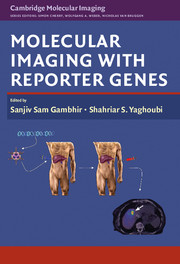Book contents
- Frontmatter
- Contents
- Contributors
- Preface
- Part I Types of Imaging Reporter Genes
- Part II Enhancing Reporter Gene Imaging Techniques
- Part III Imaging Instrumentations
- Part IV Current Applications of Imaging Reporter Genes
- 8 Reporter Gene Imaging of Cell Signal Transduction
- 9 Gene Therapy and Imaging of Transgene Expression in Living Subjects
- 10 Imaging Regulation of Endogenous Gene Expression in Living Subjects
- 11 Imaging Cell Trafficking and Immune Cell Activation Using PET Reporter Genes
- 12 Imaging of Reporter Genes and Stem Cells
- 13 Clinical Applications of Reporter Gene Technology
- Index
- References
12 - Imaging of Reporter Genes and Stem Cells
Published online by Cambridge University Press: 07 September 2010
- Frontmatter
- Contents
- Contributors
- Preface
- Part I Types of Imaging Reporter Genes
- Part II Enhancing Reporter Gene Imaging Techniques
- Part III Imaging Instrumentations
- Part IV Current Applications of Imaging Reporter Genes
- 8 Reporter Gene Imaging of Cell Signal Transduction
- 9 Gene Therapy and Imaging of Transgene Expression in Living Subjects
- 10 Imaging Regulation of Endogenous Gene Expression in Living Subjects
- 11 Imaging Cell Trafficking and Immune Cell Activation Using PET Reporter Genes
- 12 Imaging of Reporter Genes and Stem Cells
- 13 Clinical Applications of Reporter Gene Technology
- Index
- References
Summary
BACKGROUND: WHY DO WE NEED TO IMAGE STEM CELLS?
Over the last few years, cell-based regenerative medicine has appeared as a therapeutic option for many different disease states, such as musculoskeletal, endocrine, neurodegenerative, coronary artery disease, autoimmune diseases, and malignancies and has been a focus of significant attention of the scientific community. The main objective of cell-based therapies is to repopulate the damaged tissue with functional cells, with the final goal that these cells will integrate with the remaining functional native cells and contribute to the recuperation of lost function. Use of stem cells has been shown to regenerate different organs and systems, such as endocrine (e.g., pancreas), joints (i.e., cartilage), musculoskeletal (i.e., bone), and cardiovascular system (i.e., myocardium), and has also been used as adjuvant treatment for malignancies. A wide range of cell types have been used, including mesenchymal stem cells, embryonic stem cells, bone marrow-derived hematopoietic stem cells (HSCs), bone marrow-derived endothelial progenitor cells (EPCs), and neural stem cells. A significant body of knowledge has been acquired in regard to the biology of stem cells and the potential benefit of their use in tissue and organ regeneration. However, several questions remain regarding the biology of stem cells in living subjects and how they integrate with native tissue.
- Type
- Chapter
- Information
- Molecular Imaging with Reporter Genes , pp. 275 - 296Publisher: Cambridge University PressPrint publication year: 2010

